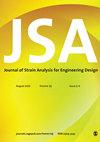基于三维扩展丰富基函数的MQ-RPIM和MLPG无网格方法在非缺口轴和缺口轴循环拉伸和弯曲载荷下I型应力强度因子和疲劳裂纹扩展估计中的适用性
IF 1.8
4区 工程技术
Q3 ENGINEERING, MECHANICAL
Journal of Strain Analysis for Engineering Design
Pub Date : 2021-08-10
DOI:10.1177/03093247211038420
引用次数: 3
摘要
本文采用无网格数值方法求解固体力学中线性弹性方程的弱形式。通过多二次基函数径向点插值无网格法(MQ-RPIM)和无网格局部Petrov-Galerkin法(MLPG)对数值无网格方法进行了评价和比较。利用这两种方法,对含有几何不连续和裂纹的弹性介质进行了基于拉伸和弯曲循环加载的应力强度因子估计。通过对具有初始表面半椭圆裂纹的缺口轴和非缺口轴在拉伸或弯曲循环载荷作用下的三维建模,确定了分析域。为了提高计算精度,采用多项式和扩展丰富的三维基函数,采用无网格RPIM方法。在PSO算法中,利用单目标函数建立了标准的形状函数和最优的参数和值。在扩展富函数的MLPG无网格方法中,通过直接法和惩罚因子法进行离散化,以获得更高效的结果并满足边界条件。将所选数值方法与实验结果和有限元数值分析结果进行效率比较,结果表明,与MLPG方法相比,MQ-RPIM富网格无网格方法在分析域节点较少的情况下,可以达到较低应力强度因子和较缓坡度的精度和收敛性。然而,MLPG无网格方法的处理时间比其他方法要短。本文章由计算机程序翻译,如有差异,请以英文原文为准。
On applicability of MQ-RPIM and MLPG meshless methods with 3D extended-enriched base functions for estimation of mode I stress intensity factor and fatigue crack growth in cyclic tensile and bending load of an un-notched and notched shaft
In this study, a numerical meshless method is used to solve the weak form of the linear elastic equations in solid mechanics. Evaluation and comparison of the numerical meshless methods have been carried out via the radial point interpolation meshless method with multi-quadrics base functions (MQ-RPIM) and meshless local Petrov-Galerkin method (MLPG). Using these two methods, stress intensity factors in an elastic medium containing geometric discontinuities and cracks are estimated based on tensile and bending cyclic loading. The analysis domain has been identified via three-dimensional modeling of the notched and un-notched shafts with an initial surface semi-elliptical crack subjected to tensile or bending cyclic loadings. To enhance the accuracy of calculations, the RPIM meshless method is applied using polynomial and extended-enriched 3D base functions. Shape functions have been developed using standard and optimal parameters and values with Mono-Objective Function in PSO algorithm. In the MLPG meshless method with the extended-enriched functions, discretization is performed via direct and penalty factor methods, to reach more efficient results and meet the boundary conditions. Efficiency comparison of the selected numerical methods with the experimental findings and the numerical analysis of finite elements method indicates that in comparison with the MLPG method, MQ-RPIM enriched meshless method can be utilized with fewer nodes in the analysis domain while reaching the accuracy and convergence with lower stress intensity factors and gentler slope. However, the processing time of the MLPG meshless method is lower than that of the other methods.
求助全文
通过发布文献求助,成功后即可免费获取论文全文。
去求助
来源期刊

Journal of Strain Analysis for Engineering Design
工程技术-材料科学:表征与测试
CiteScore
3.50
自引率
6.20%
发文量
25
审稿时长
>12 weeks
期刊介绍:
The Journal of Strain Analysis for Engineering Design provides a forum for work relating to the measurement and analysis of strain that is appropriate to engineering design and practice.
"Since launching in 1965, The Journal of Strain Analysis has been a collegiate effort, dedicated to providing exemplary service to our authors. We welcome contributions related to analytical, experimental, and numerical techniques for the analysis and/or measurement of stress and/or strain, or studies of relevant material properties and failure modes. Our international Editorial Board contains experts in all of these fields and is keen to encourage papers on novel techniques and innovative applications." Professor Eann Patterson - University of Liverpool, UK
This journal is a member of the Committee on Publication Ethics (COPE).
 求助内容:
求助内容: 应助结果提醒方式:
应助结果提醒方式:


